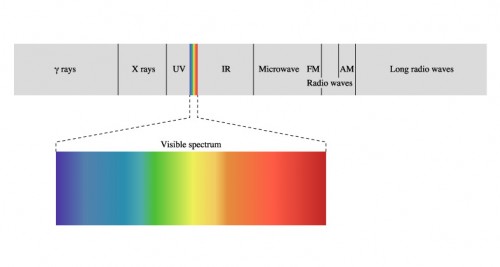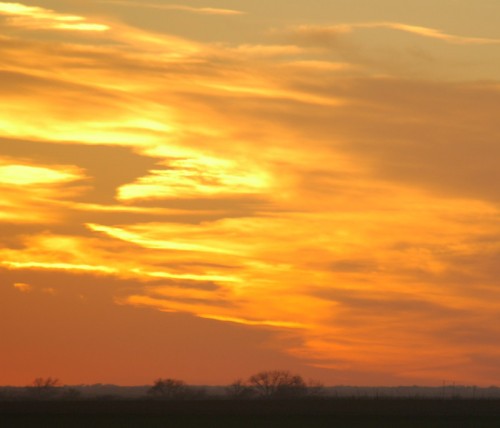Looking at Photography and Light
 You might be noticing a common theme if you’ve read through my other tutorials. But it really is ‘all about the light’. This section will guide you to understanding how photography and light work together and looking for and working with various light sources.
You might be noticing a common theme if you’ve read through my other tutorials. But it really is ‘all about the light’. This section will guide you to understanding how photography and light work together and looking for and working with various light sources.
If you want the details of light theory and physics, you won’t find it here- I will try to give you the basics of light and how it pertains to photography.
The Light Spectrum
One frustrating thing about digital photography is that the current sensors do not capture every shade and hue of color that is possible. Most cameras do a great job, but sometimes you just can’t get the color ‘perfect’.
Light comes in all flavors – you are most familiar with ‘Visible Light’ – this is easy – it’s the light that you see. But just outside of this range is UV (ultra-violet) and IR (infra-red). See the chart below to get an idea how this works:
 There are libraries full of books on just this subject, but I just wanted to show you that what you see is just a sampling of what light actually “is” and how photography and light work together (and against you).
There are libraries full of books on just this subject, but I just wanted to show you that what you see is just a sampling of what light actually “is” and how photography and light work together (and against you).
The next step to realize that the human eye is better at seeing colors than a digital camera sensor. So while you might see every color in a sunset your camera might not. If you have ever seen ‘banding’ in an photo you have taken, this is because your camera couldn’t capture all of the subtle details in the sky.
 Note the harsh changes from the brightest parts of the sky to the darker parts. This should look smoother, but was shot on an older camera (D70) in jpg mode.
Note the harsh changes from the brightest parts of the sky to the darker parts. This should look smoother, but was shot on an older camera (D70) in jpg mode.
Quick review: You can see more colors than your camera – that was easy! Now comes the more confusing part: not all cameras see the same colors.
If you compare two different cameras and take the exact same image with the same settings, you will likely see two different images. This has to do with 2 things: the different sensors, and the different internal image processing algorithms. This explains why some 12 megapixel cameras cost $100 and others cost $2000 (other factors apply).
If you already have your camera, I wouldn’t worry about it – in many cases, you’re just splitting hairs, but it’s safe to assume that the more expensive the camera or the newer the model, the better the sensor.
But then there’s one more level of confusion. The same camera can take different shots based on the “Color Space” that it is using. The chart below shows some of these differences:
 What you see in this graph is that the visible light is cut down depending upon what color space you use – and then even more when you print the image.
What you see in this graph is that the visible light is cut down depending upon what color space you use – and then even more when you print the image.
Another quick review: The color that your camera records can vary based on its settings, which is also dependent upon the camera itself, and those colors can be different from what you see. Don’t worry – remember, modern cameras rock!
A similar situation occurred back in the days of film. Kodak film generally gave warmer colors, while Fuji film provided more greens. For this reason, many people preferred Kodak for portraits and Fuji for landscapes.
Anyways – you have a camera and you’re ready to start shooting. I just wanted to make you aware of some of the factors that affect light BEFORE you even press the shutter. The rest of this section will help you understand how different forms of light affect your image.
RGB vs CMYK
Cameras record in RGB (Red, Green, Blue) – using combinations of these three color and varying intensities, millions of colors can be created. CMYK (Cyan, Magenta, Yellow, Black) is commonly used in printing. I have more information on my Photoshop tutorial website – click here. This is good to know if you are sending out a photo to be printed – do you know what color space the printer will use?
Also, if you were paying attention to the graph above, you would see that there are even a few different RGB color spaces. Your camera may not give you a choice about what color space you use, but if you have a choice, AdobeRGB will give you a little more color range.
RAW vs JPG
Another setting that determines color is shooting in what’s called RAW – this is the raw data that your camera records and then gives you full control over it later. If you shoot JPG, your camera will make some internal adjustments after you shoot and then record the JPG to a memory card. Shooting RAW will bypass this conversion and give you much more color and control.
For example, If I shoot in RAW and use the wrong White Balance setting, I can easily fix this in Photoshop by changing the White Balance when I open the file. I can also open the image as a 16bit image (JPGs are 8 bit). Oops! See what happened there? I just threw out another term. Color bit rate can vary depending upon the image type. An 8 bit image will have a possible 16.8 million colors, while a 16 bit image will have a possible 281 trillion possible colors. Wow! What a difference! In actuality, this won’t make a difference in many images – but – it will make a huge difference in capturing those difficult colors in the sunsets. Your computer screen is likely set to 32 bit (more than enough colors!)
I take photos of my friend’s paintings. The colors are vivid and varied. Think about how I have to shoot an image like this (Find out how I shoot artwork):
There is a lot to learn about photography and light and if I confused you, I’m sorry – don’t worry about it too much. As a beginner, you already have a lot to worry about. I just want to let you know that there are many, many factors that go into creating an image. If you shoot a scene and it comes out a lot different than you expected – it’s good to know that you have some options.
Questions
Do you want to learn more about the physics of light? Wikipedia will get you going.
How does your camera record light? Take a photo while you’re sitting at the computer – then view it and the actual scene at the same time. How are they similar? How different are they?
Start thinking about how much the color of light can change in your living room. From morning until night, it will vary greatly – how would you adjust for this?

